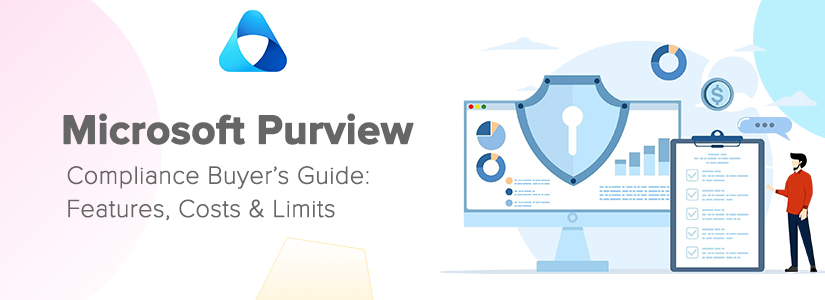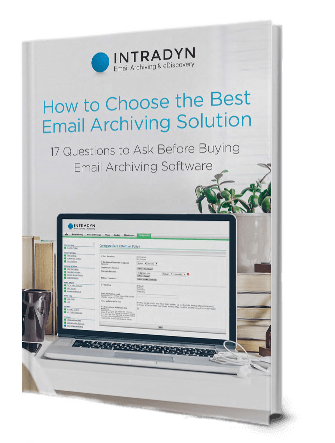Microsoft Purview Compliance Buyer’s Guide: Features, Costs & Limits

Executive Summary
Microsoft Purview is the default compliance and eDiscovery platform for organizations on Microsoft 365. It offers robust retention, eDiscovery, and governance features built directly into the ecosystem. But its structural limitations, cost model, and journaling gaps mean it may not be sufficient for regulated industries or organizations with multi-channel communication needs.
This guide explains:
- What Purview offers in compliance and eDiscovery.
- Where its limits show up in real-world operations.
- How licensing and costs work, including hidden charges.
- When and why to consider a third-party archive like Intradyn for risk mitigation.
If you are an IT manager, compliance officer, or legal lead evaluating Microsoft Purview for compliance, this buyer’s guide will give you the clarity needed to make a defensible, cost-conscious decision.
What Microsoft Purview Is and How It Fits into Compliance
Purview is Microsoft’s unified governance, compliance, and risk management platform for Microsoft 365 workloads and selected external sources. It integrates policy enforcement, data discovery, and legal hold in a single interface.
Core functional areas:
eDiscovery
- Standard: Create cases, search content, place holds, export results.
- Premium: Adds custodian management, analytics, predictive coding, transcription, translation, and review sets.
Retention & records management
- Retention policies and labels to meet business and regulatory data retention requirements.
- Preservation Lock for immutability—irreversible once applied.
- Adaptive Scopes for dynamic application based on attributes like department or geography.
Data classification & protection
- Sensitivity labels, content marking, and Data Loss Prevention (DLP) policies.
- Machine learning classifiers to detect sensitive information.
Data catalog & governance
- Purview’s unified data catalog inventories structured and unstructured data, with connectors to on-premises and cloud sources.
Who benefits most from Purview:
- Microsoft 365-centric organizations that want compliance built into their productivity stack.
- Enterprises with basic to moderate regulatory needs who value integration over best-of-breed specialization.
- Teams willing to align their processes with Microsoft’s operational model—including acceptance of platform limits.
Data Governance and Architecture in Microsoft Purview
Microsoft Purview is not just a compliance toolkit—it is also a data governance platform. At its core is the Data Map, a metadata-driven layer that discovers, catalogs, and classifies information across Microsoft 365 and connected sources.
Unified Data Map and Catalog
The Data Map automatically scans services like Exchange, SharePoint, and OneDrive, extracting metadata and applying classification labels. This metadata feeds into the Purview Catalog, giving IT managers and compliance teams a searchable inventory of their organization’s data estate. This enables:
- Faster data discovery across structured and unstructured content.
- Consistent sensitivity classification for regulatory compliance (e.g., GDPR, HIPAA).
- Centralized visibility into where sensitive data lives and how it is accessed.
Domains and Collections
Purview organizes resources into domains (broad areas such as Finance or HR) and collections (smaller, logical groupings within domains). This hierarchical model lets administrators:
- Apply governance and retention policies at scale.
- Delegate administration with role-based access control.
- Keep governance structures aligned with business units.
This structure is particularly valuable for large enterprises with distributed IT responsibilities.
Architecture and Networking
From an architectural perspective, Purview is built on Azure and relies on scanners to ingest metadata. The system stores governance data in the Data Map, with automation enabled through REST APIs, Event Hubs, and Apache Atlas integration.
Networking is flexible: organizations can use default public endpoints or restrict traffic with private endpoints for regulated environments that demand tighter network isolation. This ensures Purview can fit both open and highly secure enterprise architectures.
Strengths of Microsoft Purview for Compliance and eDiscovery
While feature parity is often assumed in compliance tools, Purview offers some unique advantages when deployed in the right context.
| Strength | Why it matters |
| Native M365 integration | Single sign-on, unified auditing, and consistent policy enforcement across Exchange, SharePoint, OneDrive, and Teams. |
| Compliance certifications | Supports configuration for regulatory frameworks (e.g., SEC 17a-4(f), FINRA, CFTC, GDPR, HIPAA) when properly deployed. See the Microsoft Trust Center for attestation details. |
| Preservation Lock | Enforces immutability by preventing policy deletion or modification after it’s locked, aiding defensibility during audits. |
| Licensing efficiency for inactive data | Inactive mailboxes preserve departed users’ data without ongoing mailbox licenses, reducing steady-state costs. |
| Flexible scope application | Adaptive scopes target users, sites, and teams dynamically (e.g., by department or region) to reduce policy sprawl and manual updates. |
| Review set analytics | Premium review sets provide clustering, near-duplicate detection, email threading, and tagging to accelerate legal review. |
Limitations of Microsoft Purview: Performance, Journaling, and Scale
Even satisfied Purview customers acknowledge practical constraints—some structural, others operational.
Throttling, Indexing Speeds, and Export Limits in Purview
Microsoft enforces tenant-wide throttling to protect overall service health. This means::
- Exports larger than a few hundred GB can stall or queue.
- Complex searches may take hours to return limits.
- Multi-terabyte cases often require staging.
Documented export limits:
| Limit type | Standard | Premium |
| Max exports/day | — | 2 TB |
| Max export size | — | 5 TB |
| Max review set size | — | 1 TB |
| Max concurrent jobs/user | 25 | 50 |
Indexing throughput
Purview indexes about 2 GB/hour per mailbox, regardless of tier. For multi-TB matters, that can translate into weeks of processing
Journaling Gap
Exchange Online cannot journal to itself — journal traffic must be sent to an on-premises server or third-party archive
API metering for Teams
Capturing Teams chat and channels at scale incurs Graph API costs beyond seeded capacity
Microsoft Purview Licensing, Costs, and Budgeting Implications
Purview’s pricing blends license tiers with pay-as-you-go (PAYG) charges, which can complicate budgeting.
4.1 Licensing
- E3: Content Search, eDiscovery Standard.
- E5 / Add-on: Required for Premium features, Insider Risk, Advanced Auditing.
PAYG Charges
- eDiscovery Premium review/export: ~$20 USD per GB/month
- Teams API overages billed separately.
Purview Cost Modeling: E3 vs. E5 vs. Premium Add-ons
| Scenario | Licensing | Estimated annual cost drivers |
| 500-seat E3 + Purview Standard | M365 E3 only | Minimal PAYG unless using connectors. |
| 500-seat E3 + Purview Premium | E3 + Premium add-on (~$8/user/mo) | Premium license + $20/GB review/export. |
| 500-seat E5 | M365 E5 | Premium features included; still subject to $20/GB charges. |
Why and When to Use a Third-Party Archive with Purview
For many regulated buyers, Purview alone is not sufficient.
Critical Reasons to Add Intradyn or Similar
- Journal-grade capture: SEC/FINRA compliance requires external, immutable journaling.
- Multi-channel ingestion: Capture of Slack, SMS, and social platforms.
- Immutable storage: WORM storage and D3P arrangements.
- Predictable costs: Flat-rate pricing avoids PAYG surprises.
- Performance independence: Faster exports and indexing outside Microsoft throttling.
Checklist: Is Your Organization Ready to Deploy Microsoft Purview?
Before committing to Purview as your primary compliance platform, evaluate:
Technical
- Confirm licensing aligns with needs.
- Map data sources in and outside Microsoft 365.
- Pilot export speed and indexing throughput.
Operational
- Train IT/legal teams in Purview workflows.
- Create workflows for partially indexed items.
- Define internal approvals for costly API collections.
Regulatory
- Align Purview retention/Preservation Lock with SEC, FINRA, GDPR, HIPAA.
- Decide if auditors require an independent archive.
Decision Framework: Purview Alone or Purview Plus a Third-Party Archive?
Ask the following:
1. Will my compliance scope extend beyond Microsoft 365 workloads?
2. Are my legal timelines compatible with Purview’s throughput and export limits?
3. Do I require journal-grade capture?
4. Is predictable cost a priority over variable usage fees?
5. Would regulator or auditor trust improve with an independent archive?
If you answer “yes” to even one, a Purview + third-party archive model often provides the best balance of governance and defensibility.
The Bottom Line for Buyers
Microsoft Purview is a powerful compliance suite when aligned with Microsoft 365’s ecosystem and operational model. It shines for organizations prioritizing integration, native policy control, and platform-wide search. However, its structural constraints—journaling gaps, throughput throttling, and PAYG costs—can make a third-party archive like Intradyn a strategic complement.
Purchasing Purview should be part of a broader compliance architecture decision, not a standalone checkbox. By understanding its capabilities, limitations, and cost structure in depth, buyers can design a solution that’s both compliant and operationally sustainable.
Frequently Asked Questions
- Does Microsoft Purview support Exchange Online journaling?
- No. Exchange Online cannot journal to an Exchange Online mailbox; use an on-premises mailbox or a third-party archive as the journal target. Source: Microsoft Learn – Configure journaling.
- What’s the difference between eDiscovery Standard and eDiscovery Premium?
- Standard supports cases, holds, search, and export. Premium adds custodians, review sets, analytics, near-duplicate detection, email threading, and predictive coding. Source: Microsoft Learn – Purview eDiscovery.
- How does pricing work for Microsoft Purview?
- Licenses (E3/E5 or add-ons) unlock feature sets; some workloads (e.g., eDiscovery Premium review sets/exports, certain governance features) are billed pay-as-you-go via Azure. Verify current rates on the pricing page. Sources: eDiscovery overview, Azure Pricing – Purview.
- How fast is Microsoft Purview eDiscovery indexing?
- Advanced indexing performance is constrained by service limits; large matters can take significant time. Microsoft documents service limits; industry analysis notes practical throughput around ~2 GB/hour per mailbox for advanced indexing. Sources: Microsoft Learn – eDiscovery Premium limits, X1 Discovery (analysis).
- How is Teams data collected, and are there extra costs?
- Teams chat/channel data relies on Microsoft Graph APIs. Beyond seeded capacity, usage is metered and billed. Source: Microsoft Graph – Teams licensing/metering.
- Does Microsoft Purview meet SEC 17a-4(f) or FINRA requirements?
- Microsoft documents configuration paths and assessments to support those requirements when properly deployed. Validate against your regulator’s expectations. Source: Microsoft Trust Center and Purview retention documentation: Retention docs.
- When should I pair Purview with a third-party archive?
- When regulatory journaling is required, when you must capture non-Microsoft channels (SMS/WhatsApp/Slack/social), when you need immutable, independent storage, or when you need predictable costs/performance for large matters. See Microsoft limits and journaling guidance: eDiscovery, limits, journaling.

